#Newtype USA
Text
Looking Back on Newtype USA 15 Years Later
“Oh no! We’ve…we’ve just received word that this is the last issue of Newtype USA magazine. Good heavens!”, reads a small line of text tucked quietly to the bottom of the final page of Newtype USA’s February 2008 issue. “There was so much anime left to watch, so much manga to read…but no worries, for we hear that the same folks are launching a new, even better magazine real soon! Wahey! Oooh, and…
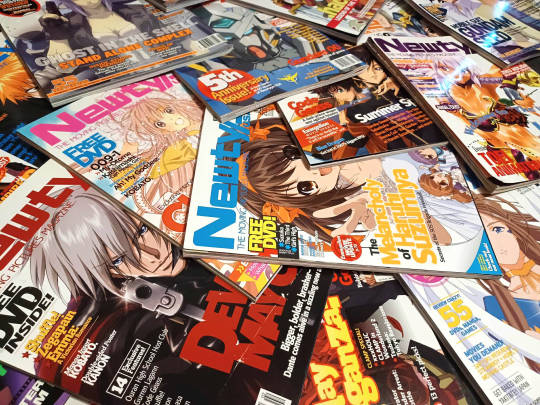
View On WordPress
3 notes
·
View notes
Text
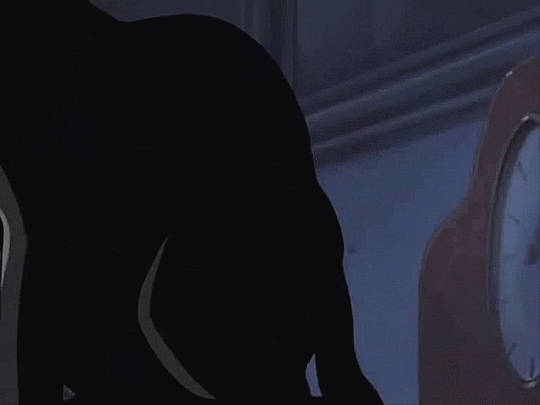

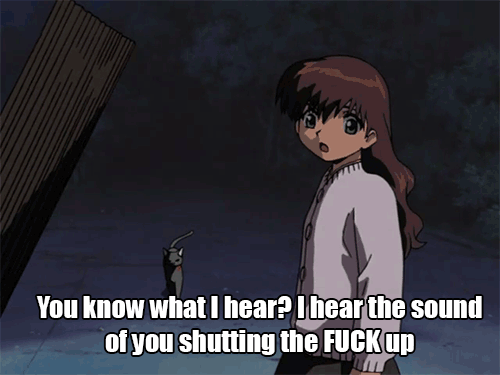


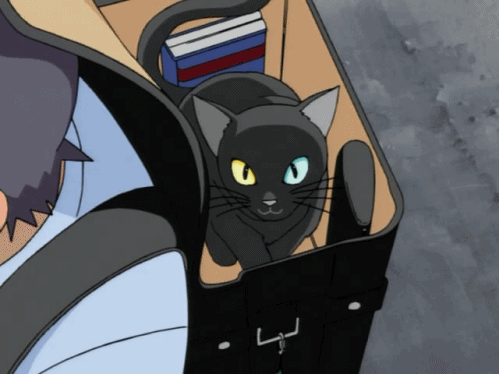
#gakkou no kaidan#ghost stories#ghost stories dub#i got this pilot on a newtype usa dvd in my youth and it forever changed me
32 notes
·
View notes
Text
God i love all this love for Trigun
I think i mentioned it before but when i watched the anime on Toonami i just loved it.
-space western
-stupid protag(s)
-angst
-amazing story
I'm gonna have to watch the old series/movie again to refresh myself, and read the manga, and then watch the new anime series but i catch myself thinking "GASP i remember that *o*"
#trigun#back then anime wasnt super cool or at least in my area#trigun and cowboy bebob were my faves#this was back when i got all my anime off toonami and the scifi channel when it would have anime feature shows#then netflix dvds and the dvds found at blockbusters and my newtype USA magazines
5 notes
·
View notes
Text
If you can help it don’t buy gunpla from Amazon. It’ll almost always be at an inflated price if it’s not a brand new batch release.
Here’s some US based shops that I’ve found/used to help you avoid using Amazon:
-Newtype
-USA Gundam Store
-Mecha Warehouse
-Gundam Planet
-Gundam Place Store
-The Gunpla Hermits Shop
-Premium Bandai US
Extra! Lose/broke a part? Check out Plamo Kitbash to order individual parts from runners (I had to do this for my Kyrios)
I’ve ordered from all of these shops so I can confirm they’re all legit
Important thing to note here tho is that shipping for some of these shops is $10 flat rate shipping without another option. So save up a little and then make a bigger cart to make it worth it more. They also have frequent sales (USAGS has one like every week on something) so keep an eye out for that as well!
Now Physical stores is kind of a mixed bag. Barnes and Noble started carrying a few kits, so did Target and Hobby Lobby (I know how we feel about HL but they also put those kits on sale every other week 40% off). But if you’re lucky enough to live close to one Hobbytown USA always has a pretty great selection and you might even seen a Grandpa statue in there too. But of course always do some searching around you and see what local hobby shops are there. Always nice to not have to pay shipping and get it straight in your hands
#feel free to add a store and I’ll add it to the list#gundam#gunpla#witch from mercury#gundam witch from mercury
295 notes
·
View notes
Text
Happy 20th anniversary FMA. Let's put some forgotten feathers back in your cap.
Melissa was the #1 anime theme song to wrap 2003, and peaked at #2 on the Oricon Singles Chart - Japan's music industry standard for charting CD singles. Melissa became the #34th top selling single for 2003 and was only on sale for two months of the year (Melissa went on sale Sept 26th and Oricon is tracked Dec 1 - Nov 30). Melissa ranked #66 in top Japanese singles for 2004 too. The song would be on the Oricon charts for 38 weeks! Melissa won Animage Magazine's 2004 Anime Grand Prix for Best Anime Song.
Ready Steady Go! was the 18th best selling single of 2004 and peaked at #1 on the Oricon Singles Chart, and would do so charting less than half the time of Melissa, 16 weeks.
FMA sweeps Animage Magazine's 26th Annual Anime Grand Prix held in June 2004 - winning best series, best male character (Ed), best female character (Riza), best voice performance (Romi Park), best song (Melissa @ #1, Kesenai Tsumi @ #2), and best episode (7).
FMA is on the cover of all 3 major Japanese animation magazines for July 2004 - Newtype, Animage, and Animedia.
July 31, 2004 L'arc~en~Ciel make their North American debut at Otakon. Prior to their concert held at the 1st Mariner Place (now CFG Bank Arena) in Baltimore, to a crowd of 12,000 the first episode of the upcoming FMA English dub is premiered.
Rewrite peaks at #4 on the Oricon charts and becomes the 63rd best selling single of 2004. Rewrite won Best Anime Theme Song at the American Anime Awards at New York City Comicon in 2007.
FMA gets the rare honour of going to reruns in Japan.
FMA debuts on Adult Swim and is on the cover of all 3 major North American anime magazines for November 2004 - Newtype USA, Anime Insider, and Animerica.
FMA pulls in a ton of new viewers to Adult Swim for December 2004.
TV Asahi ranks FMA the most popular animated TV series in Japan in fall 2005, a year after it finished airing.
FMA is the best selling anime series on DVD for 2005 in North America. Individual DVD volume sales are so strong they rank alongside anime movies.
Anime News Network crowns FMA the best series of 2005.
Link is the #4 anime song for 2005 and peaks at #2 on the Oricon chart.
Conqueror of Shamballa is the #7 anime movie and #47 movie overall in Japan for 2005.
Anime Expo 2006 celebrates FMA. AX teams up with FUNimation to premiere Conqueror of Shamballa at the convention, hosted by guests of honour: Seiji Mizushima (Series Director), Mike McFarland (EN Director), Masahiko Minami (President of Studio Bones), Romi Park (who unfortunately had to cancel last minute), and Vic Mignogna.
Conqueror of Shamballa set to screen in 40 North American theatres. In !!2006!!
In the first ever event to honour voice acting, direction, production, etc of English anime in North America, the American Anime Awards were held at New York City Comic Con in 2007, handing out awards for the Best Of 2006. Online fan voting selected the finalists and FMA led the nominations with 5. The series would lose Best Feature (CoS) to FFVII Advent Children, but win Best Long Series, Best DVD Packaging, Best Cast, and Best Theme Song (Rewrite).
Source (1), (2), (3)
Over five years after its Japanese debut and four years after it's North American start, as Brotherhood begins airing in Japan FMA still ranks #7 for best selling anime series on DVD in North America for spring 2009!
151 notes
·
View notes
Text
The Animanga Find Of A Lifetime



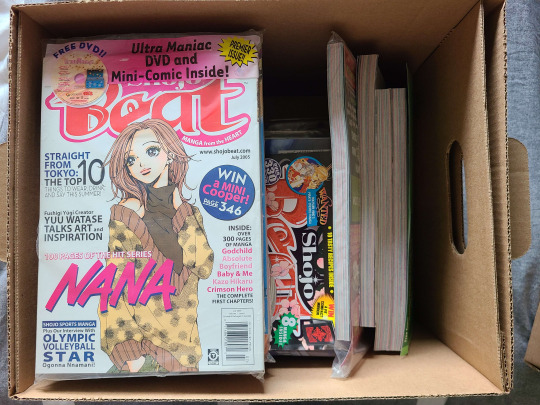

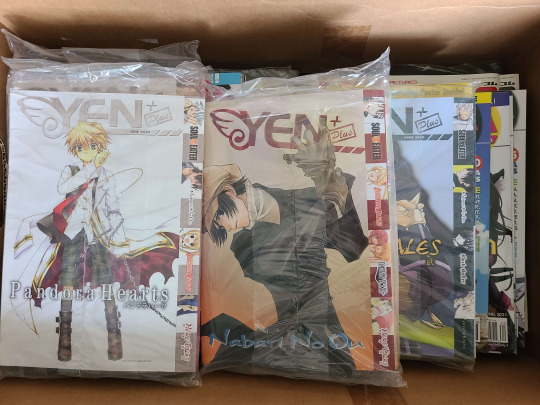
Yeah, I haven't really been too active this week. I've been busy during the week with life and whatnot, but a good chunk of the end of this week has been about this pile of anime and manga magazines. It's no longer just a "pile" of Animerica Extra, but a bonafide Mt. Everest encroaching on 400 issues, so I have lot to explain with just this haul alone.
So, where to begin? An outline is probably best.
This haul is a total of about 311 issues (a little more because of a few duplicates and magazines that aren't strongly related to animanga). That huge number is split across 16 different magazines, 4 of which (combining for 37 issues) are Japanese language.
The full list, in alphabetical order, is: Animage (JP), Animerica, Animerica Extra, Anime USA, AX (JP), AX DVD (JP), Mangajin, Neo, Newtype (JP), NewtypeUSA, OtakuUSA, Pulp, Protoculture Addicts, Shoujo Beat, Super Manga Blast, and Yen+.
Protoculture Addicts and Animerica stand out in the bunch because they together combine for over 100 of the issues in the haul, which is good because they're by far the longest running in the lot.
Speaking of those, let me give a bit of broad history in regards to the magazines.
While the majority are English language, there's actually a pair of them that were created/published outside of the US.
Starting it off, Protoculture Addicts was created in Montreal, and was actually ran as a Robotech Fanzine for about a year or so before becoming a full fledged magazine.
And then there's Neo, the UK based magazine. It's arguably the most interesting ongoing magazine out of the lot (with Otaku/Anime USA being the only others). It's also the only monthly animanga magazine to be currently published in English as OtakuUSA is bimonthly, and AnimeUSA is quarterly.
But that's enough history, what about the insides? For the most part they're relatively standard, but there's not "as many" manga anthology issues in this mountain.
Super Manga Blast, Shoujo Beat (only 9 issues), Animerica Extra (which I now have extras of), Pulp (only 2 issues), and Yen+.
That last one is the most interesting to me purely because of an editorial/column penned by "The Otaku Pimp". Yeah, that's a real thing that appears in that magazine which is incredibly funny to me.
More on the interesting side though is Mangajin, a magazine focused on teaching Japanese through Japanese culture, which of course includes manga. This one is especially interesting because it oftentimes features the only instance of the manga inside being translated to English.
And this is all just the tip of the iceberg. There's an insane amount of information and history in the magazines, and an exciting amount of unknowns with the frankly incredible amount of promotional DVDs that remain attached to so many of these issues.
I just have to get through it all.... which will take a long time. Will certainly be recruiting friends and whoever to help out, so hopefully I won't be doing this for the rest of my life haha
#anime haul#manga haul#anime magazine#manga magazine#viz media#viz manga#viz#dark horse comics#dark horse manga#yen press#anime#manga#anime and manga
21 notes
·
View notes
Text

Speaking of magazines, feast your eyeballs on this! It's a two page advertisement for the first DVD of Invader Zim, circa an anime magazine (Newtype USA) from 2004!
8 notes
·
View notes
Text
i'm literally ten minutes away from USA gundam store but i don't have a car with which to go there so i feel weird ordering from them and paying for shipping so instead i always end up buying my model kits from newtype on the opposite side of the country
43 notes
·
View notes
Note
Congratulations to you on reaching 3,000 followers! And thank you for running this fun tournament to celebrate! In Fullmetal Alchemist character popularity contests, Ed and Roy so often take the top two spots, and as much as I love those characters, it is refreshing to see their counterparts Al and Riza take the top two spots for a change. Also, although I voted for Riza, I think that Hiromu Arakawa would possibly be pleased by Al's win. When Newtype USA magazine interviewed her for an article in their January 2006 issue, she reportedly told them that she identified with Al.
Thank you so much! 🥹🫶🏻3️⃣0️⃣0️⃣0️⃣
We’re so, so glad you enjoyed the tournament! It really means the world to us <33
We didn’t anticipate this outcome at all, so we’re pleasantly surprised that both Roy’s and Ed’s counterparts were the ones taking the top spots this time around! Go Al and Riza! 🥰
(Mod Mustang is also always VERY happy to see Riza do well! 🤭)
It is the greatest honour to think that we might have also even pleased the great Arawaka 😍

- Mod Mustang & Mod Hawkeye 🔥🦅
#fma#fmab#fullmetal alchemist#metal meme#fullmetal alchemist brotherhood#roy mustang#riza hawkeye#best fma character royal rumble#alphonse elric#ask us anything!
16 notes
·
View notes
Text
Addressing the Troubles: Part 2 / 3
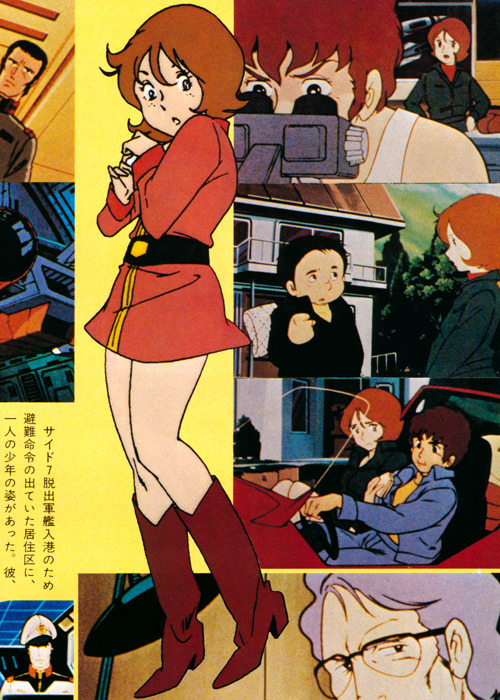

A Brief History of Gundam in Japan and the USA:
Here is my go-to analogy: The Gundam franchise is to Japan what Star Trek is to America. And Gundam Wing is to the Gundam franchise what Deep Space 9 is to the rest of Star Trek.
Wing was part of an experimental phase in the franchise’s history; when they were intentionally trying to break away from the usual modus operandi. Wing, along with the earlier G Gundam, was intended to boost flagging viewership and sell model kits– like, expressly, openly, just to sell model kits. The plan was to start from a blank slate that would allow new viewers to hop on board, without having to be caught up on the sprawling canon of the UC timeline (Universal Century).
In Japan, audiences were already familiar with the general premise of A Gundam Show; rather than spend any extra time re-establishing details that an already Gundam-savvy audience would know, it skipped right to explaining on how this particular series was departing from the established material. In this case, the noteworthy information was that Wing takes place in the After Colony timeline, and is set wholly in its own universe– we have a different sinister organization with a ‘Z’ in its name, a different mysterious blond man who wears a mask, a different conflict between Earth and Space, and no mention of Newtypes.
Perhaps the most significant difference between Wing and its predecessor was its tonal shift. In the original Mobile Suit Gundam (if seasoned fans will pardon my oversimplification), the good guys are a relatively wholesome bunch or reluctant civilian heroes coming together to survive, a found-family supporting each other and trying their best to protect the vulnerable. It’s just ONE Gundam, and a crew of overworked, under-supplied misfits. It’s still very much a complex narrative about the horrors of war, but like, there’s a goofy side-kick robot! Kids run around White Base causing shenanigans! The more the UC timeline progresses, the more complicated it gets, but the point is, it’s a different style of complicated. There's a relatable and familiar flavor to its protagonists and their struggles.
Pan over to Wing, where we are served right away with the spiciest plate of the spiciest feral murder boys, possibly the LEAST reluctant people ever to get in a mecha and cause harm.
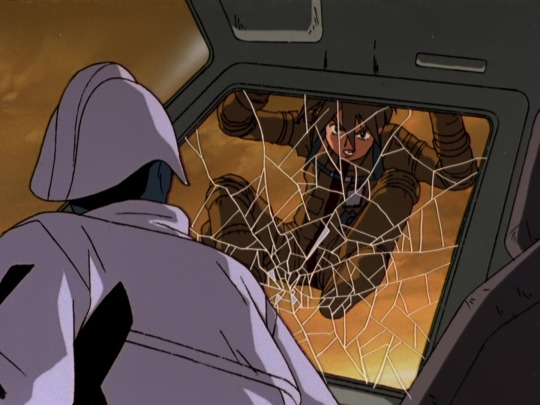
The protagonist pilots are remorseless teenagers who were robbed of their adolescence before the show even began, and thrown into the meatgrinder of revolutionary violence– not the most relatable bunch, and not one audience surrogate amongst them (that honor goes to Relena). None of them work together, everyone is morally ambiguous, and they’re all hyper-competent elite soldiers from the get-go. In MS Gundam, Amuro spends his first fight in the Gundam trying to learn to walk and shoot using a manual.
Some Gundam fans were quite put off by this change, but in the USA, we had no basis for comparison. Gundam Wing was the only Gundam show we had, and furthermore, it was one of the first “serious” “cartoons” introduced to mainstream television. And it blew. Our. Fucking. Minds.
--I cannot stress enough how influential that early 2000’s Toonami programming block was in introducing anime to American audiences, and by extension, American television producers and toy companies. I recommend checking out this IGN article about the history of GW’s debut on Cartoon Network, and the effect it had on the industry at large: How Gundam Wing Found Its Home On Toonami 20 Years Ago Today . For another take on the phenomenon check out: Found in Translation: How Gundam Wing Became A Global Phenomenon (Opinions are those of the article writer, not mine.)
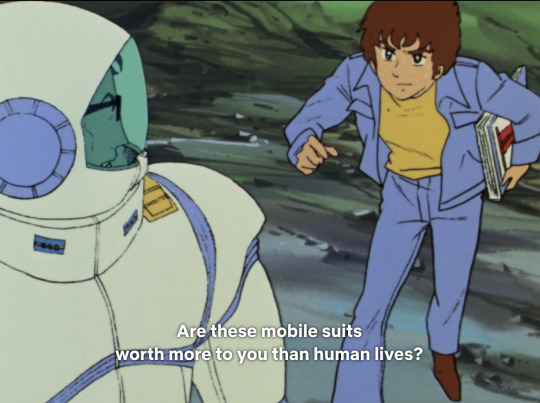


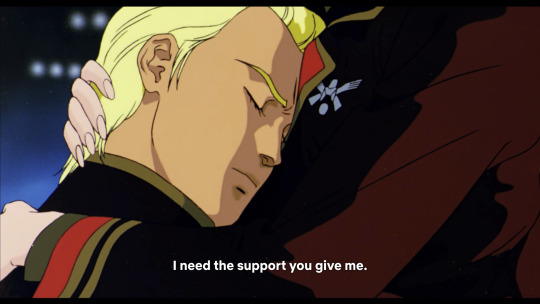

For those of you who are of that Toonami-block generation who never encountered the original series: MS Gundam is truly gripping and powerful, and if you’re not already a Gundam fan but found that Wing tickled your fancy, the original line up of shows will probably be right up your alley too. Be prepared for a very different overall experience from Wing though– for one thing, you may be surprised to discover that the original series, with its earlier animation style and dated anime tropes, is absolutely fucking brutal.
Fundamentally, the original Gundam is a series that is steeped to its core in a very somber, distinctly post-war Japanese melancholy that Wing, for all its lofty philosophizing, lacks. I don’t mean to make that a criticism of Wing– it had a much, much shorter run to make its point, and it was intentionally trying to do something different from its parent series.
Gundam Wing may at one point had a reputation for being Gundam’s dark, broody, edgy cousin, but Wing is also as chaste as a Victorian romance novel, and obscures most of its violence in clean, bloodless explosions. In the first episode of MS Gundam you will be treated to first-hand mass civilian death. In the movie and at various points of the shows there are scenes deliberately and uncomfortably reminiscent of the atomic bombing of Hiroshima and Nagasaki. In Zeta Gundam, you'll get to explore a wide selection of Horrible Ways To Die In Space that I suspect would have the same effect on a child as accidentally watching Watership Down (1978) thinking it was a Disney movie. (That's right: It makes you a more interesting person with good taste!) There's also like, nudity. And adults, with messy, adult relationship problems.
The U.C. timeline is just a lot more, I want to say, earthy as a rule. The characters are normal people and they have a wide range of interests and relationships to each other. Even when it’s reaching those philosophical high-notes, the focus is closer to the ground level; you see the day to day struggles of the crew, of civilians, of couples, you see their private lives, watch them evolve over the course of many years, how they fall in love, eat burgers, hook up, make friends, and make bad decisions. It’s a rich, diverse world filled with believable, complex people; the world building has more time to fill out, with its roots firmly in the soil of classic science fiction writing and space exploration; and it does what it sets out to do, which is deliver a gut-punch of an anti-war story.
If you take anything away from this, it’s that developing a tolerance for older mediums and long-term relationships with particular stories will give you access to some of the most rewarding experiences possible. And that’s true of many things, but especially of stories that have had lasting cultural impact and serve as time capsules for the struggles of their era. It’s true of The Iliad, it’s true of Lord of the Rings, it’s true of Akira, it’s true of Gundam.
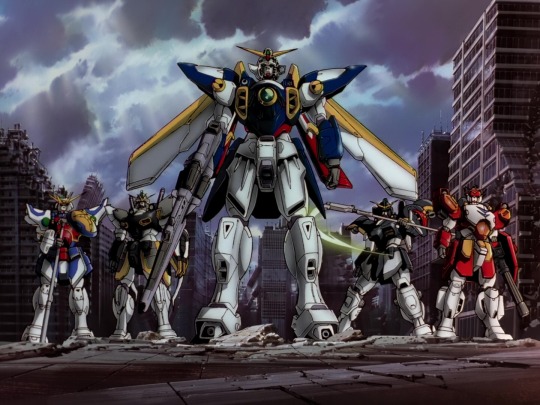
“Just Make Us Five Gundams” – Wing’s Famously Troubled Production & Why You Should Read Episode Zero
Gundam Wing was created flying by the seat of its pants from start to finish.
Hideyuki Tomioka, executive producer on Wing, was still early in his career when he was cut loose on a new Gundam series with minimal oversight.
“Just make us a show with FIVE new Gundams”, Bandai said. “It’ll sell model kits!”, they said. “It’ll be fun!”, they said. And they laughed, and laughed.
But Tomioka agreed, and set out to assemble his creative team– notably, Masashi Ikeda (series director), Katsuyuki Sumisawa (series composition / head scriptwriter), and Shuko Murase (character designer). Many of his chosen production crew had never worked on a Gundam show before, but everyone knew their stuff, and had been selected for their outstanding work or for showing promise in their respective fields.
--Please, pour one out for them now.
The production schedule for Wing was apparently one of the roughest in Sunrise’s history. In a 2017 interview, producer Tomioka explains: “With Wing, we delivered the episodes to the TV network a week early. All of them. I was told by the producers at the network that there would be hell to pay if this next Gundam wasn’t delivered a week early like clockwork, and I said sure. I also told Mr. Ikeda and the company that we would maintain a one-week-before-air delivery schedule, and we delivered every single episode a week before air.”
Head scriptwriter Sumisawa recalls camping in the Sunrise studio and working all night without sleeping in order to turn in scripts on time (something I vividly recall doing with my senior thesis).
Despite the entire staff being burnt out from the continuous workflow, the team apparently met every single deadline, and still consider Gundam Wing to be some of their best work.
However, Wing’s trouble didn’t end with just the frantic schedule.
Significant, under-the-table leadership changes at the studio level made a bad situation worse. Just before the production of Wing, parent company Sunrise had sold the Gundam franchise to Bandai, apparently in secret, leaving their creatives and producers like Tomioka in a lurch. The sudden change in sponsors led to an attitude change that would filter through the company, causing significant friction and splintering within the organization.
In fact, creative control of the series was tossed in the air at multiple levels:
When series director Masashi Ikeda was hired for Wing, he was coming off a few rocky dismissals / resignations from earlier projects due to his disagreements with sponsors. He was new to Gundam, but was known for being a talented, if contentious, storyboard artist / director. Right away he took Wing in an unexpected direction, apparently derailing the series from its original trajectory after only 10 episodes. Signing off on these provocative decisions may have painted a target on his back, but it certainly made Wing stand out from its predecessors! Perhaps predictably, Ikeda either “abruptly resigned” or was fired from the project after Episode 29, and was substituted by Gundam franchise veteran, Shinji Takamatsu. Takamatsu would ultimately finish directing the remaining half of the series, though he was left uncredited.
Sumisawa too withdrew as a the lead scenario writer. He reports having to cope with curve balls thrown in the script by different writers who hadn’t run their decisions by him first, leaving him to struggle with reworking episodes at the last minute in order to accommodate the unsupervised changes.
All the crunch and chaos, the impossibly tight schedules, the directorial and creative control changing hands mid-series, led to many of the important plot points and connective tissue that had been slated for reveal at the midpoint of the series being severely truncated, or scrapped entirely.
--And this, friends, is why there are so many instances in the early episodes of Wing where characters make reference to events and concepts that simply never show up in the series– the material got cut for time, and the unexplained anecdotes were left to dangle.
This includes by far the most unfortunate omission in the series: the pilot backstories. In the postscript of “Gundam Wing: Episode Zero”, the manga prequel released seven years after the series first aired– scriptwriter Sumisawa makes this plea:
“[...] I would like to make a request of those who have read this book. I would like you to watch the entire TV series and Endless Waltz again. By so doing, I think you will be able to fully appreciate the work, Gundam Wing.
This series of stories of the past was requested of me by Director Ikeda, and it was supposed to appear in the to the p20the TV series after episode 27. However, it was pigeonholed roduction schedule being the worst ever, and the fact that I withdrew ws scenarist.
When I returned to the show, there was no chance to fit in the past, and we had no choice but to table it indefinitely (though we did try in episode 31, The Glass Kingdom). It was able to become a graphic novel through the kindness of the editors at Anime V Magazine and Mr. Kanbe's (artist) cooperation. As one of the co-creators, I am extremely grateful, and this has become a very emotional work.”
In one interview, Sumisawa laments: “Nobody wants to write recap episodes. Episodes 27 and 28 were recap episodes.” Producer Tomioka notes that “Everybody worked some serious miracles for part two. We never would have been able to do part two [of the series] if we hadn’t put in those recap episodes. It really was rough.”
--This Is why I recommend that people read Episode Zero around the time they get to the mid-series point in the anime, where the backstories were always meant to go. Many, MANY questions and frustrations that I hear from first-time watchers will be cleared up.
It’s a damn good collection of stories, too! As you can see, my own copy is nearing a level of decrepitude that ought to make it Nursery Real at this point. I took it everywhere with me in my school bag as a comfort item.
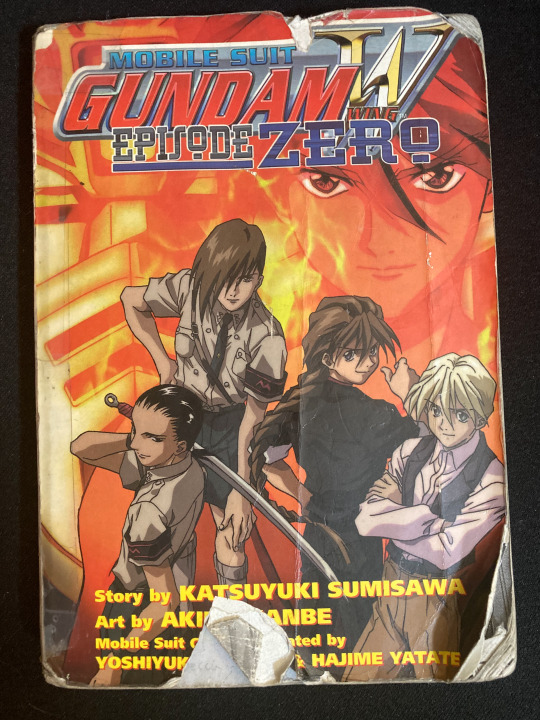
–A link to the manga can be found in the Bookshelf section!
11 notes
·
View notes
Text
Obscure Animation Subject #55: Serial Experiments Lain
Originally posted on Twitter on April 15, 2023.
Created by Yasuyuki Ueda, written by Chiaki J. Konaka and directed by Ryūtarō Nakamura, this is a 13-episode miniseries produced by Triangle Staff, and aired on TV Tokyo from July 6 to September 28, 1998.
The series follows Lain Iwakura, an adolescent girl in suburban Japan, and her relation to the Wired, a global communications network similar to the internet. The show is an original idea to the point of it being considered "an enormous risk" by its producer Yasuyuki Ueda.
Ueda had to answer repeated queries about a statement made in an Animerica interview. He stated that Lain was "a sort of cultural war against American culture and the American sense of values we [Japan] adopted after WWII". He later expanded this in numerous interviews.
He created Lain with a set of values he took as distinctly Japanese; he hoped Americans would not understand the series as the Japanese would. This would lead to a "war of ideas" over the meaning of the anime, hopefully culminating in new communication between the two cultures.
When he discovered that the American audience held the same views on the series as the Japanese, he was disappointed. The Lain franchise was originally conceived to connect across forms of media (anime, video games, manga), but due to its failure that was scrapped.
Ueda said in an interview, "the approach I took for this project was to communicate the essence of the work by the total sum of many media products". The scenario for the video game was written first, and the video game was produced at the same time as the anime series.
However, the anime was released first. A dōjinshi titled "The Nightmare of Fabrication" was produced by Yoshitoshi ABe and released in an artbook An Omnipresence in Wired. Ueda and Konaka declared that the idea of a multimedia project wasn’t unusual in Japan, as opposed for Lain.
Despite the show’s confusion to the audience it wanted to appeal to, critics responded positively to the thematic and stylistic characteristics, and it was awarded an Excellence Prize by the 1998 Japan Media Arts Festival for "its question the meaning of contemporary life".
According to Christian Nutt from Newtype USA, the main attraction to the series is its keen view on "the interlocking problems of identity and technology". Nutt saluted Abe's "crisp, clean character design" and the "perfect soundtrack" in his 2005 review of series.
He said that "Serial Experiments Lain might not yet be considered a true classic, but it's a fascinating evolutionary leap that helped change the future of anime." Anime Jump gave it 4.5/5, and Anime on DVD gave it A+ on most criteria with some As for volume 3 and 4.
Lain was subject to commentary in the literary and academic worlds. The Asian Horror Encyclopedia calls it "an outstanding psycho-horror anime about the psychic and spiritual influence of the Internet". It notes that the red spots present in all the shadows look like blood pools.
It also notes the death of a girl in a train accident is "a source of much ghost lore in the twentieth century", more so in Tokyo. Gilles Poitras describes it as a "complex and somehow existential" anime that "pushed the envelope" of anime diversity in the 1990s.
Susan J. Napier in her 2003 reading to The Problem of Existence in Japanese Animation, compared the show to Ghost in the Shell and Spirited Away. According to her, the main characters of the two other works cross barriers; they can cross back to our world, but Lain can’t.
Napier asks whether there is something to which Lain should return, "between an empty 'real' and a dark 'virtual'". Mike Toole named SEL as one of the most important anime of the 90s. Anime Academy gave the series a 75%, but criticized it due to the "lifeless" setting it had.
Michael Poirier of EX magazine stated that the last three episodes fail to resolve the questions in other DVD volumes. Justin Sevakis of Anime News Network noted that the English dub was decent, but that the show relied so little on dialogue that it hardly mattered.
So all in all, this show is one of the weirdest shows out there, but despite being a miniseries, it still has significance thanks to the bizarre nature and sci-fi themes. Not in the levels of Neon Genesis Evangelion or Cowboy Bebop, but still really interesting to go through.

3 notes
·
View notes
Note
... Would it be wrong to ask you to fact check my ask by looking up either the profiles or the January 2006 issue of Newtype USA it supposedly came from as a source? The Mignola one, specifically?
I don't have Newtype magazine, so if it's not online there's nothing I can do, unfortunately. I can say for a fact that it's not in the English version of the profiles book because I read it over and over as a kid and I would remember if it mentioned this the Gold-Toothed Doctor didn't exist at the time of that book's release. I can check the other guidebooks when I get home for winter break.
2 notes
·
View notes
Note
I'm curious... how did you come across Final Fantasy Unlimited?

Oh my let me talk about my LOVE!
You see I'm old. (No seriously, I am. I'll be 35 next month) and well back in my time 20 years ago when I was a kid, we had Newtype USA magazine. Anime was NOT big back when I was a kid. It was still quite a small but growing market so various dubbing companies (ADV, Bandai, Funimation, etc) would give single episodes from new and upcoming animes to this magazine for a "sample DVD" and FFU was on one of those same DVDs with episode 1.
Newtype had manga chapters in it too
Well my friend in High School bought the first two DVDs of FFU and as you do when you're a broke high schooler and anime is difficult to find because the popularity is NOT there - we shared everything. So if one of us bought a new series (DVD or Manga) we ALL watched / read it .
So my friend bought FFU 1 and 2 and shared them with my entire friend group and it took over my life! I bought ALL the DVDs starting on Vol 3 as they released. I even have the shiny Collector's Edition box that came with the first volume! 💙
FFU was just something I became obsessed with in High School and here we are 20 years later. Kumo still owns my life LOL.
#storiesinsong#stories-in-song#ask || mun speaks#// Oh how I adore FFU#// I have all of it on my computer in a digital format if anyone ever wants to Watch Party / Live stream it with me#// and I mean I own it all on DVD too of course
5 notes
·
View notes
Text
Ok so incoming gunpla post about tools:
So you’ve started building! It’s fun! It’s cathartic! And they look so cool!
But…
You kinda want them to look Even Cooler.
You also don’t have a ton of cash and you’re feeling intimidated by how deep this hobby can take you (you’ve seen those cool customs online). No worries! Here’s a couple cheapish (<$40) tools to help you get rolling on taking your kits to the next level.
1) Sanding Sponge/Glass File

These are great bc 1) they’re cheap and 2) do the job wonderfully. Specifically they’re for helping to remove Nub marks off the price you’ve cut from the runner. If you don’t know, Nubs are the leftover plastic still attached to the piece after you’ve clipped it from the runner, they’re important to remove bc of how the kit is engineered. Moving gimmicks or the sturdiness of the kit could be compromised if your pieces can’t fit flush.
The sponge is the cheapest option but it also runs out at some point and you’ll need to replace them. However, the glass file will simply just keep rolling. I bought mine from Newtype about a year and a half ago and it’s still doing great. I believe Walmart might have even cheaper options.
2) Gundam Marker

So you know those grooves on a part that’s sunken in? Those are called Panel Lines! Using this pen (it’s basically a Micron pen) you can color in these lines to help give your kit extra depth. This is especially great on kits that are primarily a single color with few variations (think Calibarn).
All you do is draw in your line and then wipe away with your finger or paper towel or what have you. These are super cheap and you’ll run through half a dozen or so HG’s or even MG’s before you need to think about getting a new one. With this you also don’t need to worry about top coating or being mindful about what you’re applying it over (unlike other panel liners where you need to keep some chemistry in mind).
3) Single Blade Nippers

So these are the most expensive item and while double blade nippers work absolutely, you’ll end up creating less work for yourself with single blade nippers as they can make cleaner cuts off the runner meaning you have less nub to clean up.
These ones I snagged from USA Gundam Store (they give a discount for snagging these) and they work great. Not the greatest durability over multiple kits as they really lose that initial sharpness over the first kit or two, but they stay sharp enough to do the job well. There’s several different options out there (some as expensive as $60 or so) but starting out a cheaper pair is great to have.
I used double sided nippers for the longest time but after switching I firmly believe they’re worth the extra $$ to invest in.
To elaborate on 2 bladed vs single bladed a bit: double blades cut from both sides (obviously) but what this means is that there is stress being applied to the piece from each side. This causes stress marks (if you’ve seen a white spot left behind after a clip that’s a stress mark) which either need cleaned up and painted over or it causes a crater in the part (especially easy to do when the nub is especially large) which either never gets fixed or you need to use tamiya cement to melt plastic and then puddy it innnnn and thennnnn sand everything againnnnn and it’s a pain.
Save yourself the headache. Singe blade nippers are the way. I especially hate those beginner nippers that look like this

I hope this helps you dig a little further down into the plastic crack rabbit hole! With just a little extra effort you can really make your kits pop. You can do it!
As always I really love seeing all the new people building gunpla and making it their own (special shout out to that person who bedazzled their guncannon). Love ya friendos
#I’ve been meaning to make this for a while#make sure to check the notes bc I’m sure other will add other easy tools#which is TOTALLY fine to do btw!#good luck peeps#gunpla#gundam#wfm#g witch#witch from mercury#plamo
126 notes
·
View notes
